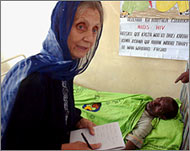New TB strains pose global threat
US researchers predict that super drug-resistant forms of tuberculosis are at the tipping point of a global epidemic, and only small changes are needed to help them spread quickly.

Two separate studies show that multiple-drug-resistant TB, which can be cured only with a carefully monitored and lengthy cocktails of drugs, could easily start spreading more commonly.
The reports, to be published in Monday’s issue of the journal Nature Medicine, coincide with another report published last week saying the World Health Organisation’s efforts to control multi-drug-resistant TB were not working as well as hoped.
If all the reports are true, it means that TB could make a dangerous new resurgence, and with new strains that are even harder to fight than the old ones.
TB infects an estimated 8.7 million people a year and kills two million a year despite widespread control efforts.
The disease is spread by airborne bacteria that settle into the lungs and cause long-term infection. Many people who are infected do not become ill themselves but can spread it.
Tough hygiene and treatment campaigns beat TB in places such as Europe and North America, but AIDS, with its attacks on the immune system, helped TB make a comeback in the 1990s.
Antibiotics resistant strains
TB is making big gains in Eastern Europe and Southeast Asia.
 |
|
Hot spots for the new strain |
Strains resistant to several antibiotics are becoming increasingly prevalent, with “hot spots” in Russia, Eastern Europe, South Africa, China and Israel.
WHO’s main strategy to control it is called “directly observed treatment, short course” or DOTS, which involves using trained health professionals to watch patients take their long courses of antibiotics.
Even a little carelessness in taking antibiotics can help TB mutate into drug-resistant forms.
But some scientists had found that the mutant strains, while difficult to eradicate in the host patients, were not easily spread to other people.
So health professionals in many countries focus on treating TB patients with drugs.
Disaster
The two papers in Nature Medicine say this could lead to disaster.
Even if just a few TB strains develop the ability to spread, they will eventually take over and dominate, say Sally Blower and Tom Chou of the University of California, Los Angeles, and Megan Murray and Ted Cohen of the Harvard School of Public Health.
They developed separate mathematical models that show it would be easy for multi-drug-resistant TB to out-compete other strains and spread.
“We should not be reassured by studies that suggest mutated TB is less transmissible,” said Murray.
“It is imperative that strategies to control tuberculosis include measures to treat individuals with MDR (multi-drug-resistant) disease,” Cohen added in a statement.
“It can be done. Our model shows why making this treatment available is absolutely necessary to avoid otherwise inevitable MDR-TB epidemics.”